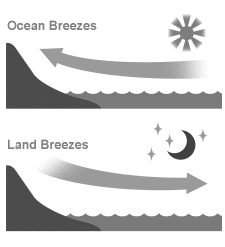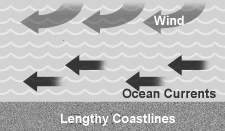 Ocean Conditions 1 Ocean Conditions 1
Wind or ocean currents have a great influence over the waters in which we dive. When the surfing is good, the diving isn’t. The most suitable conditions for diving are when there are no waves or current.
|
|
■Waves
Waves have their origins primarily in wind, and while there may be no wind blowing near the coast, there may be winds blowing in the open sea which can cause high waves to break on the shore. If high waves break, the ocean bottom is stirred up, causing silt to blur visibility.
As well, as waves approach the shore, they collapse, causing undertow and rip currents. In this region - the surf zone – it is easy to have your feet pulled out from under you, especially with all your equipment on, so caution is required. |
 |
|
|
■Land Breezes and Ocean Breezes
During the day, most breezes originate over the ocean. These daytime ocean breezes, affected by high pressure under the influence of the sun, are quickly warmed over the water’s surface. The resulting rise of air causes the phenomenon. Conversely, in the evening, the land is cooler than the ocean, so breezes originate over land and blow towards the sea.
|
 |
|
|
■Topography and Ocean Currents
Winds that follow lengthy, unbroken coastlines create long shore currents. So far as shallows exist near the shore, undertows are created, and at breaks in the shallows, strong rip currents are created. As well, where there are groupings of large rocks, complex water channels are created which require caution.
|

 |
|
|

